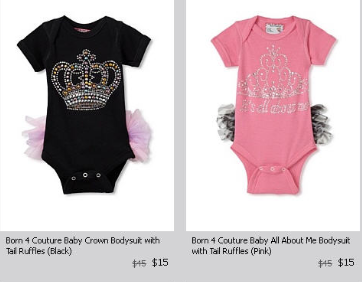In this talk, statistician Hans Rosling looks at whether, globally, religion impacts national fertility rates. His conclusion? Nah, not really. He also points out that while fertility rates are certainly correlated with national income levels, it’s no longer true that a nation must be wealthy before experiencing significant reductions in fertility rates. While all of the nations with fertility rates of 6 or more children per woman are, indeed, quite poor, many similarly poor countries have fertility levels similar to that in much wealthier nations — an average of about 2 children per woman.
gender
The splashy introduction of the new LEGO friends line earlier this year stirred up a lot of controversy. My goal with this set of posts is to provide some historical perspective for the valid concerns raised in this heated debate.
This is Part III, see also:
—————————
2004-2011: Lean LEGO Fighting Machine
As discussed in Part II, between 1989 and 2003, LEGO had introduced a stream of lines aimed specifically at girls. None were particularly successful and the company was in trouble. So, what next?
Those of us who follow every move TLG makes are well familiar with the company’s near collapse in 2004 and subsequent renaissance. This is a really important moment for our story, because this is the year when TLG stopped being a family run business and brought in a non-Kristiansen CEO, Jorgen Vig Knudstorp. With Knudstorp’s arrival came a change in philosophy. Quoted from the DailyMail article linked above:
Instead of “nurturing the child” – as Knudstorp puts it – [employees’] primary goal now had to be, “I am here to make money for the company.”
I, like many LEGO fans, am very grateful for what Knudstorp did to save and revitalize the company. The post-2004 era has seen a flourishing of LEGO themes and sets aimed at advanced builders. The LEGO minifig has been injected with more personality and variety than ever before. However, part of TLG’s new strategy also involved abandoning efforts the girl market and focusing exclusively on boys.
Abandoning schlock like Belville and Clikits is not a bad thing, but the push toward conflict and hyper-masculinity in classic themes (and a whole host of new ones) made LEGOLAND inhospitable for femininity. Here are a couple more telling quotes from the Daily Mail article:
As always with Lego, this [action-oriented theme] was developed at every stage… with the help of focus groups, mostly comprising boys aged between six and 12.
In this new world focused on profit, the company sees no shame in admitting that, like it or not, what most excites little boys is conflict.
Which is to say, LEGO City is not the tranquil place LEGO Town was.
Notice the substantial hike in the m/f ratio in 2007. This ratio had been gradually approaching 1 throughout the 90s, but jumped back up to 1992 levels in 2007 (male/female ratio = 8).
Girls also disappeared from LEGO commercials and marketing collateral. LEGO produced a series of commercials encouraging fathers and sons to build together; the utter lack of anything similar for girls sends a clear message about who is expected to play with LEGO, it has entirely entered the masculine domain. With girls being actively excluded from TLG’s marketing efforts it’s no surprise that we see such a low percentage playing with them now.
In the final installment of this series, I’ll offer my perspective on the controversy over the new line aimed at girls, LEGO Friends.
—————————
David Pickett is a social media marketer by day and a LEGO animator by night. He is fanatical about LEGO and proud to be a nerd. Read more from David at Thinking Brickly.
Lisa Wade, PhD is an Associate Professor at Tulane University. She is the author of American Hookup, a book about college sexual culture; a textbook about gender; and a forthcoming introductory text: Terrible Magnificent Sociology. You can follow her on Twitter and Instagram.
Cross-posted at Montclair SocioBlog.
The politics of motherhood reared its head again last month when Hilary Rosen, who the news identified as a “Democratic strategist,” said that Ann Romney (Mrs. Mitt) had “never worked a day in her life.” (A NY Times article is here.)
“Worked” was a bad choice of words. Raising kids and taking care of a home are work, maybe even if you can hire the kind of help that Mrs. Romney could afford. Rosen’s comment implied that family work is not as worthwhile as work in the paid labor force. That’s not such an unreasonable conclusion if you assume that we put our money where our values are and reward work in proportion to what we think it’s worth. Mitt’s supporters use this value-to-society assumption to justify the huge payoffs Romney derived from those leveraged buyouts at Bain Capital.*
Even Mrs. Romney apparently felt that there must be some truth to the enviability of a career. Why else would she refer to stay-at-home motherhood as a career? “My career choice was to be a mother.”
Still, regardless of the truth of Rosen’s remark, it was insulting.** Stay-at-home motherhood is work – a job.
But is it a good job?
A recent Gallup poll provides some more evidence as to why stay-at-home moms might be both envious or resentful of their employed counterparts. Gallup asked women about the emotions, positive and negative, that they had felt “a lot” in the previous day. Gallup then compared the stay-at-home moms, employed moms, and employed women who had no children at home.
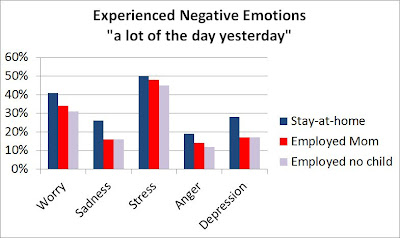
The stay-at-home moms came in first on every negative emotion. Some of the differences are small, but the Gallup sample was more than 60,000 so these differences are statistically significant. The smallest difference was for Stress – no surprise there, since paid work can be stressful. Worry and Anger too can be part of the workplace. The largest differences were for Sadness and Depression. Stay-home moms were 60% more likely to have been sad or depressed.
Gallup also asked about positive feelings (Thriving, Smiling or Laughing, Learning, Happiness, Enjoyment), and while the differences were smaller, they went the same way, with stay-at-home moms on the shorter end. Still it’s encouraging that 86% of them had Experienced Happiness 86%; so had 91% of the employed moms.
Money matters. As Rosen said,
This isn’t about whether Ann Romney or I or other women of some means can afford to make a choice to stay home and raise kids. Most women in America, let’s face it, don’t have that choice.
Gallup found a small interaction effect. The stay-at-home mom-employed difference was greater for low-income women.
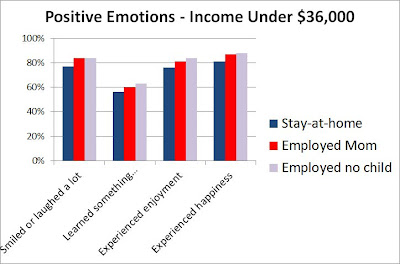
The Gallup poll does not offer much speculation about why stay-at-home moms have more sadness and less happiness. One in four experienced “a lot” of depression yesterday. That number should be cause for concern.
Maybe women feel more uncertain and less able to control their lives when they depend on a man, especially one whose income is inadequate. Maybe stay-at-home moms find themselves more isolated from other adults. Maybe they are at home not by choice but because they cannot find a decent-paying job. Or maybe money talks, and what it says to unpaid stay-at-home moms is society does not value your work. Nor, in comparison with other wealthy countries, does US society or government provide much non-financial support to make motherhood easier.
The late Donna Summer sang,
She works hard for the money
So you better treat her right
But how right are we treating women who work hard for no money?
——————————-
* For example, Edward Conrad is a former partner of Romney. In a recent article in the Times Magazine, Adam Davidson writes, “If a Wall Street trader or a corporate chief executive is filthy rich, Conrad says that the merciless process of economic selection has assured that they have somehow benefitted society.”
** Hillary Clinton committed a similar gaffe twenty years ago in response to a reporter’s question about work and family “I suppose I could have stayed home and baked cookies and had teas, but what I decided to do was to fulfill my profession which I entered before my husband was in public life”
Today I thought we’d do another round-up of gendered children’s stuff, since we’ve gotten a number of submissions. So here we go.
Missy C. noticed that the manufacturer’s product description listed on Amazon for one of the Fisher Price Imaginext Sky Racers took for granted that the toy was for boys, not, say, “kids”:
Monica C., meanwhile, noticed another example of the association of girls with a diva-ish princess center-of-attention persona when looking at onesies for sale at My Habit. Options included “born fabulous,” “high maintenance,” “born to wear diamonds,” and “it’s all about me,” among others:
Similarly, Melanie J. saw some baby booties for sale at retail chain JR’s in North Carolina that reinforce the idea that boys are mischievous while girls are materialistic:
You can buy them gendered vitamins as well. Nathan, who writes at 1115, sent in this photo he took at Target:
Pete & Emily in Norwich, UK, noticed that you can now allow your hamsters to inhabit gendered worlds too, if you’d like; they sent us this photo they took at a pet store:
But we do have two counter-examples this time! Jackie H. took a photo of a kitchen set she saw for sale at Meijer, which shows both a boy and a girl using it:
And Isabeau P.S., Jesse W., and Anne Sofie B. all sent in images from the catalog for Swedish toy maker Leklust (two of the images were discussed at Mommyish):
The splashy introduction of the new LEGO friends line earlier this year stirred up a lot of controversy. My goal with this set of posts is to provide some historical perspective for the valid concerns raised in this heated debate.
————————
1989-2003: Gender Ahoy!
I discussed the introduction of LEGOs the invention of gendered minifigs, and early efforts to market separately to girls and boys in Part I of this series, covering 1932 to 1988. The segregation of LEGO into feminine and masculine sets would escalate beginning in 1989. That year the LEGO group introduced gender to the minifig in a big way with the new Pirates theme. The masculine figs sported copious facial hair and the lone feminine pirate had lipstick and a curved shirt that implied a busty chest.
This pioneering pirate was the first in a long line of token females in otherwise male-dominated action-centric themes. The imbalanced ratio of masculine to feminine minifigs persists today, though it has lessened over time. I have seen several different numbers for this ratio, so I decided to do my own count. I gave TLG the benefit of the doubt and counted as gender neutral any minifigs lacking definitely masculine (facial hair) or feminine (lipstick, eyelashes, cleveage) traits, even when LEGO marketing materials clearly delineate them as male or female.
The following graphs represent masculine minifigs in blue, feminine minifigs in red, and gender neutral minifigs in gray. I have also calculated the masculine to feminine ratio (m/f ratio). Ideally this should be 1, indicating that there are equal number of masculine and feminine figures. This chart shows the aggreagate across all themes for the five key years between 1989 and 1999. The m/f ratio for this data is 3.74 (which is a lot better than the initial 13.5 it starts at in 1989, but not exactly something to celebrate).
The trend to unrepresent feminine figures in the main LEGO product line is mirrored by a tendency to overrepresent them in the “girls only” lines. LEGO released four major “girls only” themes through this time period: Paradisa, Belville, Scala Dolls, and Clikits. Here’s a quick run down of the “girls only” themes:
- Paradisa deserves props for using standard minifigs, but the building experience is simplified compared to other LEGO sets released the same year (compare the Sand Dollar Cafe with Wolf Pack Tower). Also it represents men as active job holders (butlers, chefs, ice cream men, and life guards) while the women mostly relax, surf, and go horseback riding.
- Belville is the longest running “girls only” theme and also the pinkest and most gender stereotype reinforcing. The classic LEGO building experience is barely present; the sets favor gigantic pre-fabricated “walls” and floors, and the completed “houses” and “horse stables” don’t even look like their real-life counterparts. The figures are completely out of scale with minifgs, so while it is possible to use pieces from Belville in LEGOLAND and vice versa, it is unrealistic.
- Scala Dolls was essentially LEGO barbie. Here’s the dreamhouse. It has even less construction play than Belville.
- The Clikits jewelry line featured pieces that are barely compatible with regular LEGO bricks (some people might not even think to try.) The line also contained some Bratz-esque characters.
The message that these themes send to children about gender is clear — certain things are for girls only. Namely: fairy tales, equestrianism, the color pink, vanity, and being a homemaker. Boys shouldn’t want these things and the girls that don’t are lesser for it.
The chart below aggregates figures from the first three of those lines across all years they existed (since Clickits was a jewelry line, it didn’t really feature figures). Beyond the inversely unbalanced the m/f ratio of 0.18 (roughly one masculine figure for every five feminine figures), it is also important to note that the percentage of neutral figs is incredibly low, so playing with these sets reinforces the either/or of gender roles:
Lest you think girls get all the special treatment, fear not, boys get their share of “boys only” themes. We’ve already discussed Trains and Technic which have long, proud, histories and exist in a blue and black anti-Belville realm (Technic even had Belville-sized masculine articulated figures for a while). In 1998 the ill-fated Znap bucked the trend of “boys only” themes being for advanced builders. It was simple to put together (like K’nex), but never caught on despite being viral. 1998 also saw the creation of a Technic subtheme with even more testosterone than usual: Competition. 2001 saw TLG try to bridge the gap between DUPLO and SYSTEM (for boys) with Jack Stone. 2001 was also the launch of TLG’s attempt to get in to the action figure market: Bionicle. This is arguably a gender-neutral theme, but considering that TLG forgot to include girl’s names for an online character creator for Bionicle’s successor, it’s clear that TLG does not think boys and girls can enjoy the same toys.
As a final note on this era, observe this graph of the m/f ratio on minifigs over time. Notice how it is on the decline (towards gender balance) before sharply increasing in the early 2000s? We’ll explore the reasons for that in the next installment.
Read Part III of A Historical Perspective on the LEGO Gender Gap.
—————————
David Pickett is a social media marketer by day and a LEGO animator by night. He is fanatical about LEGO and proud to be a nerd. Read more from David at Thinking Brickly.
Lisa Wade, PhD is an Associate Professor at Tulane University. She is the author of American Hookup, a book about college sexual culture; a textbook about gender; and a forthcoming introductory text: Terrible Magnificent Sociology. You can follow her on Twitter and Instagram.
Last week, on the heels of Obama’s announcement that he supports gay marriage, NPR interviewed the President of the Pew Research Center, Andrew Kohut, about trends in American support for the issue. Kohut explained that American opinion has changed dramatically, and unusually, in a very short time. In 1996, for example, 27% of people supported gay marriage (65% opposed). This “really didn’t change very much” for a while. In 2004, when Republicans mobilized the issue to get conservatives to the polls, 60% still opposed it. But today, in the space of less than a decade, we have more people supporting gay marriage than opposing it. Some polls show the majority of Americans believe that we should have the right to marry someone of the same sex.
This trend is driven, in part, by young people replacing the old, but focusing on this overshadows the fact that essentially all Americans — of every stripe — show higher support for gay marriage than they did a decade ago. Both men and women and people of all races, political affiliations, religions, and ages are showing increased support for gay marriage. This is a real, remarkable, and rare shift in opinion:
Opinion by age: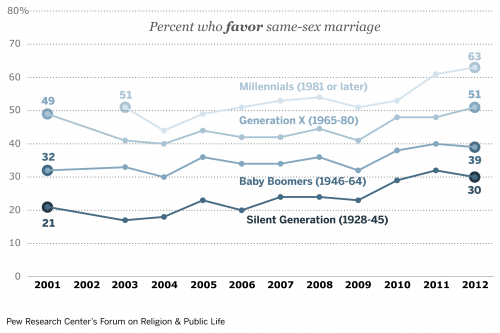
Opinion by religion: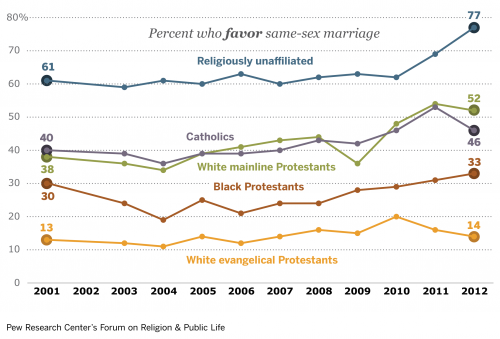
Opinion by political party: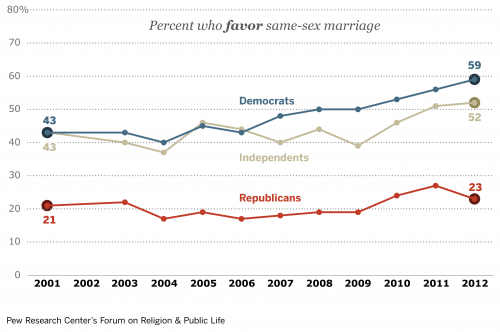
Opinion by political orientation: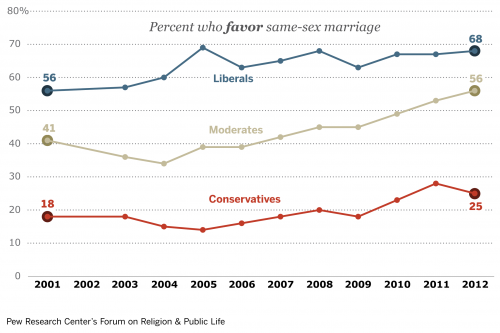
Opinion by race: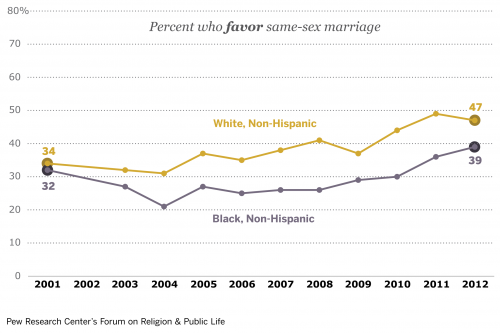
Opinion by gender: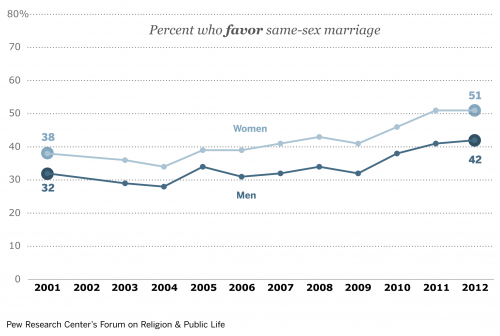
Via Montclair SocioBlog.
Lisa Wade, PhD is an Associate Professor at Tulane University. She is the author of American Hookup, a book about college sexual culture; a textbook about gender; and a forthcoming introductory text: Terrible Magnificent Sociology. You can follow her on Twitter and Instagram.
Sociologists have observed that employment in the U.S. is largely structured around an assumption that the worker has no family responsibilities. The ideas that an employee should be able to work during non-school hours, stay late when needed, take off time for their own illness but never anyone else’s, for example, all presume that the workers have either no children or someone else taking care of children for them.
Most jobs, then, are not designed to be compatible with family responsibilities. Since most people doing primary child care are women, this hurts mothers disproportionately. Mothers have a more difficult time being the “perfect employee” and also face discrimination from employers. This translates into some telling numbers. Women make about 69% of what men make (not controlling for type of occupation), but most of this disadvantage is related to parental status, not sex. Women without children make 90% of what men make, while mothers make 66%. Ann Crittenden’s book, The Price of Motherhood, lays out these numbers starkly.
These issues are at the heart of this well-crafted Ampersand cartoon by B. Deutsch, which prompted this post in anticipation of Mother’s Day in the U.S.
Lisa Wade, PhD is an Associate Professor at Tulane University. She is the author of American Hookup, a book about college sexual culture; a textbook about gender; and a forthcoming introductory text: Terrible Magnificent Sociology. You can follow her on Twitter and Instagram.
 In this three-minute clip, sociologist Shelley Correll discusses her research on the “motherhood penalty.” The phrase refers to the finding that being a mom specifically, not just being female or being a parent, leads to lower income. Scholars have begun to realize just how significant this is. As Correll explains, the pay gap between women with and without children is larger than that between women and men:
In this three-minute clip, sociologist Shelley Correll discusses her research on the “motherhood penalty.” The phrase refers to the finding that being a mom specifically, not just being female or being a parent, leads to lower income. Scholars have begun to realize just how significant this is. As Correll explains, the pay gap between women with and without children is larger than that between women and men:
For more, see the full text of Correll’s paper titled “Getting a Job: Is There a Motherhood Penalty.”
Lisa Wade, PhD is an Associate Professor at Tulane University. She is the author of American Hookup, a book about college sexual culture; a textbook about gender; and a forthcoming introductory text: Terrible Magnificent Sociology. You can follow her on Twitter and Instagram.
The splashy introduction of the new LEGO friends line earlier this year stirred up a lot of controversy. My goal with this set of posts is to provide some historical perspective for the valid concerns raised in this heated debate.
This is Part III, see also:
—————————
2004-2011: Lean LEGO Fighting Machine
As discussed in Part II, between 1989 and 2003, LEGO had introduced a stream of lines aimed specifically at girls. None were particularly successful and the company was in trouble. So, what next?
Those of us who follow every move TLG makes are well familiar with the company’s near collapse in 2004 and subsequent renaissance. This is a really important moment for our story, because this is the year when TLG stopped being a family run business and brought in a non-Kristiansen CEO, Jorgen Vig Knudstorp. With Knudstorp’s arrival came a change in philosophy. Quoted from the DailyMail article linked above:
Instead of “nurturing the child” – as Knudstorp puts it – [employees’] primary goal now had to be, “I am here to make money for the company.”
I, like many LEGO fans, am very grateful for what Knudstorp did to save and revitalize the company. The post-2004 era has seen a flourishing of LEGO themes and sets aimed at advanced builders. The LEGO minifig has been injected with more personality and variety than ever before. However, part of TLG’s new strategy also involved abandoning efforts the girl market and focusing exclusively on boys.
Abandoning schlock like Belville and Clikits is not a bad thing, but the push toward conflict and hyper-masculinity in classic themes (and a whole host of new ones) made LEGOLAND inhospitable for femininity. Here are a couple more telling quotes from the Daily Mail article:
As always with Lego, this [action-oriented theme] was developed at every stage… with the help of focus groups, mostly comprising boys aged between six and 12.
In this new world focused on profit, the company sees no shame in admitting that, like it or not, what most excites little boys is conflict.
Which is to say, LEGO City is not the tranquil place LEGO Town was.
Notice the substantial hike in the m/f ratio in 2007. This ratio had been gradually approaching 1 throughout the 90s, but jumped back up to 1992 levels in 2007 (male/female ratio = 8).
Girls also disappeared from LEGO commercials and marketing collateral. LEGO produced a series of commercials encouraging fathers and sons to build together; the utter lack of anything similar for girls sends a clear message about who is expected to play with LEGO, it has entirely entered the masculine domain. With girls being actively excluded from TLG’s marketing efforts it’s no surprise that we see such a low percentage playing with them now.
In the final installment of this series, I’ll offer my perspective on the controversy over the new line aimed at girls, LEGO Friends.
—————————
David Pickett is a social media marketer by day and a LEGO animator by night. He is fanatical about LEGO and proud to be a nerd. Read more from David at Thinking Brickly.
Lisa Wade, PhD is an Associate Professor at Tulane University. She is the author of American Hookup, a book about college sexual culture; a textbook about gender; and a forthcoming introductory text: Terrible Magnificent Sociology. You can follow her on Twitter and Instagram.
Cross-posted at Montclair SocioBlog.
The politics of motherhood reared its head again last month when Hilary Rosen, who the news identified as a “Democratic strategist,” said that Ann Romney (Mrs. Mitt) had “never worked a day in her life.” (A NY Times article is here.)
“Worked” was a bad choice of words. Raising kids and taking care of a home are work, maybe even if you can hire the kind of help that Mrs. Romney could afford. Rosen’s comment implied that family work is not as worthwhile as work in the paid labor force. That’s not such an unreasonable conclusion if you assume that we put our money where our values are and reward work in proportion to what we think it’s worth. Mitt’s supporters use this value-to-society assumption to justify the huge payoffs Romney derived from those leveraged buyouts at Bain Capital.*
Even Mrs. Romney apparently felt that there must be some truth to the enviability of a career. Why else would she refer to stay-at-home motherhood as a career? “My career choice was to be a mother.”
Still, regardless of the truth of Rosen’s remark, it was insulting.** Stay-at-home motherhood is work – a job.
But is it a good job?
A recent Gallup poll provides some more evidence as to why stay-at-home moms might be both envious or resentful of their employed counterparts. Gallup asked women about the emotions, positive and negative, that they had felt “a lot” in the previous day. Gallup then compared the stay-at-home moms, employed moms, and employed women who had no children at home.

The stay-at-home moms came in first on every negative emotion. Some of the differences are small, but the Gallup sample was more than 60,000 so these differences are statistically significant. The smallest difference was for Stress – no surprise there, since paid work can be stressful. Worry and Anger too can be part of the workplace. The largest differences were for Sadness and Depression. Stay-home moms were 60% more likely to have been sad or depressed.
Gallup also asked about positive feelings (Thriving, Smiling or Laughing, Learning, Happiness, Enjoyment), and while the differences were smaller, they went the same way, with stay-at-home moms on the shorter end. Still it’s encouraging that 86% of them had Experienced Happiness 86%; so had 91% of the employed moms.
Money matters. As Rosen said,
This isn’t about whether Ann Romney or I or other women of some means can afford to make a choice to stay home and raise kids. Most women in America, let’s face it, don’t have that choice.
Gallup found a small interaction effect. The stay-at-home mom-employed difference was greater for low-income women.

The Gallup poll does not offer much speculation about why stay-at-home moms have more sadness and less happiness. One in four experienced “a lot” of depression yesterday. That number should be cause for concern.
Maybe women feel more uncertain and less able to control their lives when they depend on a man, especially one whose income is inadequate. Maybe stay-at-home moms find themselves more isolated from other adults. Maybe they are at home not by choice but because they cannot find a decent-paying job. Or maybe money talks, and what it says to unpaid stay-at-home moms is society does not value your work. Nor, in comparison with other wealthy countries, does US society or government provide much non-financial support to make motherhood easier.
The late Donna Summer sang,
She works hard for the money
So you better treat her right
But how right are we treating women who work hard for no money?
——————————-
* For example, Edward Conrad is a former partner of Romney. In a recent article in the Times Magazine, Adam Davidson writes, “If a Wall Street trader or a corporate chief executive is filthy rich, Conrad says that the merciless process of economic selection has assured that they have somehow benefitted society.”
** Hillary Clinton committed a similar gaffe twenty years ago in response to a reporter’s question about work and family “I suppose I could have stayed home and baked cookies and had teas, but what I decided to do was to fulfill my profession which I entered before my husband was in public life”
Today I thought we’d do another round-up of gendered children’s stuff, since we’ve gotten a number of submissions. So here we go.
Missy C. noticed that the manufacturer’s product description listed on Amazon for one of the Fisher Price Imaginext Sky Racers took for granted that the toy was for boys, not, say, “kids”:
Monica C., meanwhile, noticed another example of the association of girls with a diva-ish princess center-of-attention persona when looking at onesies for sale at My Habit. Options included “born fabulous,” “high maintenance,” “born to wear diamonds,” and “it’s all about me,” among others:
Similarly, Melanie J. saw some baby booties for sale at retail chain JR’s in North Carolina that reinforce the idea that boys are mischievous while girls are materialistic:
You can buy them gendered vitamins as well. Nathan, who writes at 1115, sent in this photo he took at Target:
Pete & Emily in Norwich, UK, noticed that you can now allow your hamsters to inhabit gendered worlds too, if you’d like; they sent us this photo they took at a pet store:
But we do have two counter-examples this time! Jackie H. took a photo of a kitchen set she saw for sale at Meijer, which shows both a boy and a girl using it:
And Isabeau P.S., Jesse W., and Anne Sofie B. all sent in images from the catalog for Swedish toy maker Leklust (two of the images were discussed at Mommyish):
The splashy introduction of the new LEGO friends line earlier this year stirred up a lot of controversy. My goal with this set of posts is to provide some historical perspective for the valid concerns raised in this heated debate.
————————
1989-2003: Gender Ahoy!
I discussed the introduction of LEGOs the invention of gendered minifigs, and early efforts to market separately to girls and boys in Part I of this series, covering 1932 to 1988. The segregation of LEGO into feminine and masculine sets would escalate beginning in 1989. That year the LEGO group introduced gender to the minifig in a big way with the new Pirates theme. The masculine figs sported copious facial hair and the lone feminine pirate had lipstick and a curved shirt that implied a busty chest.
This pioneering pirate was the first in a long line of token females in otherwise male-dominated action-centric themes. The imbalanced ratio of masculine to feminine minifigs persists today, though it has lessened over time. I have seen several different numbers for this ratio, so I decided to do my own count. I gave TLG the benefit of the doubt and counted as gender neutral any minifigs lacking definitely masculine (facial hair) or feminine (lipstick, eyelashes, cleveage) traits, even when LEGO marketing materials clearly delineate them as male or female.
The following graphs represent masculine minifigs in blue, feminine minifigs in red, and gender neutral minifigs in gray. I have also calculated the masculine to feminine ratio (m/f ratio). Ideally this should be 1, indicating that there are equal number of masculine and feminine figures. This chart shows the aggreagate across all themes for the five key years between 1989 and 1999. The m/f ratio for this data is 3.74 (which is a lot better than the initial 13.5 it starts at in 1989, but not exactly something to celebrate).
The trend to unrepresent feminine figures in the main LEGO product line is mirrored by a tendency to overrepresent them in the “girls only” lines. LEGO released four major “girls only” themes through this time period: Paradisa, Belville, Scala Dolls, and Clikits. Here’s a quick run down of the “girls only” themes:
- Paradisa deserves props for using standard minifigs, but the building experience is simplified compared to other LEGO sets released the same year (compare the Sand Dollar Cafe with Wolf Pack Tower). Also it represents men as active job holders (butlers, chefs, ice cream men, and life guards) while the women mostly relax, surf, and go horseback riding.
- Belville is the longest running “girls only” theme and also the pinkest and most gender stereotype reinforcing. The classic LEGO building experience is barely present; the sets favor gigantic pre-fabricated “walls” and floors, and the completed “houses” and “horse stables” don’t even look like their real-life counterparts. The figures are completely out of scale with minifgs, so while it is possible to use pieces from Belville in LEGOLAND and vice versa, it is unrealistic.
- Scala Dolls was essentially LEGO barbie. Here’s the dreamhouse. It has even less construction play than Belville.
- The Clikits jewelry line featured pieces that are barely compatible with regular LEGO bricks (some people might not even think to try.) The line also contained some Bratz-esque characters.
The message that these themes send to children about gender is clear — certain things are for girls only. Namely: fairy tales, equestrianism, the color pink, vanity, and being a homemaker. Boys shouldn’t want these things and the girls that don’t are lesser for it.
The chart below aggregates figures from the first three of those lines across all years they existed (since Clickits was a jewelry line, it didn’t really feature figures). Beyond the inversely unbalanced the m/f ratio of 0.18 (roughly one masculine figure for every five feminine figures), it is also important to note that the percentage of neutral figs is incredibly low, so playing with these sets reinforces the either/or of gender roles:
Lest you think girls get all the special treatment, fear not, boys get their share of “boys only” themes. We’ve already discussed Trains and Technic which have long, proud, histories and exist in a blue and black anti-Belville realm (Technic even had Belville-sized masculine articulated figures for a while). In 1998 the ill-fated Znap bucked the trend of “boys only” themes being for advanced builders. It was simple to put together (like K’nex), but never caught on despite being viral. 1998 also saw the creation of a Technic subtheme with even more testosterone than usual: Competition. 2001 saw TLG try to bridge the gap between DUPLO and SYSTEM (for boys) with Jack Stone. 2001 was also the launch of TLG’s attempt to get in to the action figure market: Bionicle. This is arguably a gender-neutral theme, but considering that TLG forgot to include girl’s names for an online character creator for Bionicle’s successor, it’s clear that TLG does not think boys and girls can enjoy the same toys.
As a final note on this era, observe this graph of the m/f ratio on minifigs over time. Notice how it is on the decline (towards gender balance) before sharply increasing in the early 2000s? We’ll explore the reasons for that in the next installment.
Read Part III of A Historical Perspective on the LEGO Gender Gap.
—————————
David Pickett is a social media marketer by day and a LEGO animator by night. He is fanatical about LEGO and proud to be a nerd. Read more from David at Thinking Brickly.
Lisa Wade, PhD is an Associate Professor at Tulane University. She is the author of American Hookup, a book about college sexual culture; a textbook about gender; and a forthcoming introductory text: Terrible Magnificent Sociology. You can follow her on Twitter and Instagram.
Last week, on the heels of Obama’s announcement that he supports gay marriage, NPR interviewed the President of the Pew Research Center, Andrew Kohut, about trends in American support for the issue. Kohut explained that American opinion has changed dramatically, and unusually, in a very short time. In 1996, for example, 27% of people supported gay marriage (65% opposed). This “really didn’t change very much” for a while. In 2004, when Republicans mobilized the issue to get conservatives to the polls, 60% still opposed it. But today, in the space of less than a decade, we have more people supporting gay marriage than opposing it. Some polls show the majority of Americans believe that we should have the right to marry someone of the same sex.
This trend is driven, in part, by young people replacing the old, but focusing on this overshadows the fact that essentially all Americans — of every stripe — show higher support for gay marriage than they did a decade ago. Both men and women and people of all races, political affiliations, religions, and ages are showing increased support for gay marriage. This is a real, remarkable, and rare shift in opinion:
Opinion by age:
Opinion by religion:
Opinion by political party:
Opinion by political orientation:
Opinion by race:
Opinion by gender:
Via Montclair SocioBlog.
Lisa Wade, PhD is an Associate Professor at Tulane University. She is the author of American Hookup, a book about college sexual culture; a textbook about gender; and a forthcoming introductory text: Terrible Magnificent Sociology. You can follow her on Twitter and Instagram.
Sociologists have observed that employment in the U.S. is largely structured around an assumption that the worker has no family responsibilities. The ideas that an employee should be able to work during non-school hours, stay late when needed, take off time for their own illness but never anyone else’s, for example, all presume that the workers have either no children or someone else taking care of children for them.
Most jobs, then, are not designed to be compatible with family responsibilities. Since most people doing primary child care are women, this hurts mothers disproportionately. Mothers have a more difficult time being the “perfect employee” and also face discrimination from employers. This translates into some telling numbers. Women make about 69% of what men make (not controlling for type of occupation), but most of this disadvantage is related to parental status, not sex. Women without children make 90% of what men make, while mothers make 66%. Ann Crittenden’s book, The Price of Motherhood, lays out these numbers starkly.
These issues are at the heart of this well-crafted Ampersand cartoon by B. Deutsch, which prompted this post in anticipation of Mother’s Day in the U.S.
Lisa Wade, PhD is an Associate Professor at Tulane University. She is the author of American Hookup, a book about college sexual culture; a textbook about gender; and a forthcoming introductory text: Terrible Magnificent Sociology. You can follow her on Twitter and Instagram.
 In this three-minute clip, sociologist Shelley Correll discusses her research on the “motherhood penalty.” The phrase refers to the finding that being a mom specifically, not just being female or being a parent, leads to lower income. Scholars have begun to realize just how significant this is. As Correll explains, the pay gap between women with and without children is larger than that between women and men:
In this three-minute clip, sociologist Shelley Correll discusses her research on the “motherhood penalty.” The phrase refers to the finding that being a mom specifically, not just being female or being a parent, leads to lower income. Scholars have begun to realize just how significant this is. As Correll explains, the pay gap between women with and without children is larger than that between women and men:
For more, see the full text of Correll’s paper titled “Getting a Job: Is There a Motherhood Penalty.”
Lisa Wade, PhD is an Associate Professor at Tulane University. She is the author of American Hookup, a book about college sexual culture; a textbook about gender; and a forthcoming introductory text: Terrible Magnificent Sociology. You can follow her on Twitter and Instagram.






